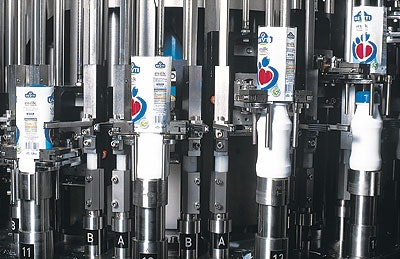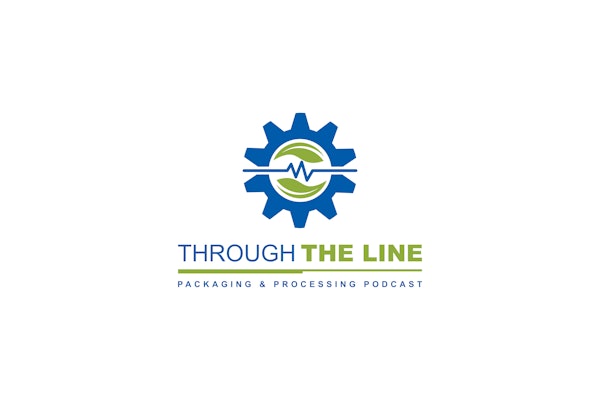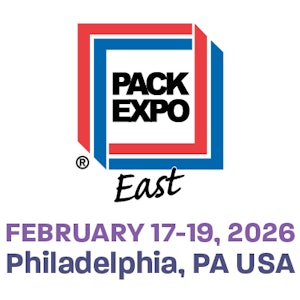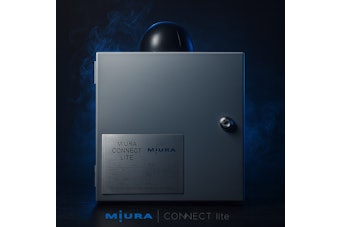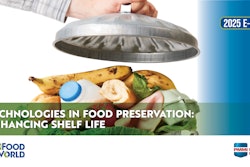Halfway between the historic Egyptian cities of Alexandria and Cairo is a glistening new dairy where some of the world’s most advanced aseptic packaging technology is or soon will be on display. How thoroughly was the facility’s packaging equipment researched?
“We visited nearly 90 plants around the world and conducted research for five years,” says Hesham Sheta, vice chairman of International Group for Investments, one of the largest business conglomerates in Egypt. “The plant is just part of an integrated project. We have 7ꯠ acres of agricultural land surrounding the dairy plant where we plan to operate a dairy farm of 27ꯠ cows that will supply milk to the plant.”
The first liquid products launched by IGI, available since June, were Beyti-brand whole milk aseptically packaged in 250-mL, 1-L, and 1.5-L bottles. Also launched was Spiky-brand flavored milk in 250-mL bottles only. Coextrusion blown in-house, the bottles are white high-density polyethylene/carbon black plus regrind/white HDPE. The carbon black keeps light from attacking the light-sensitive milk. Empty bottle weights are 14, 30, and 40 g. Colorful graphics on shrink-sleeve labels give the bottles real shelf impact.
Shelf life, says Sheta, is technically a year. But the bottles will be coded with a six-month best-if-used-by date.
A key goal of IGI’s bold packaging initiative is to grow the market, says Sheta. The potential is enormous, he adds.
“Some 85 percent of the milk consumed in Egypt is bought fresh and unpasteurized from a milk man on a bicycle or motorcycle or from a local dairy shop,” says Sheta. “The consumer boils it in the home before consuming it. Long term, that’s our market, and it’s huge.”
Capturing that market will require patience. Egypt–with a population of 70 million, and with as many as 18 million in a city like Cairo—is just now developing the kind of socioeconomic infrastructure that is capable of supporting the growth of packaged and branded food and beverage products. More supermarkets would help, and the recent arrival of Carrefour, a well-known French chain, suggests that more supermarkets may well be on the way.
In the meantime, IGI’s real competitor is the aseptically filled boxes that a few dairies in Egypt use for milk. Sheta believes that the advantages a plastic bottle has over a brick pack–cost, reclosability, convenience, and appearance–will quickly make his firm’s Beyti brand milk the preferred shelf-stable brand.
Asbofill technology
Filling at IGI is notable because the firm is one of the first to install an Asbofill aseptic bottle-filling system, developed by GEA. Although GEA is headquartered in Buchen, Germany, the division chiefly responsible for the IGI installation was GEA Tuchenhagen of Ireland. Worth noting is that shortly after the IGI installation, GEA sold its Asbofill technology to Techne (Bologna, Italy).
Like the aseptic filling equipment recently developed by two or three other machinery suppliers, the Asbofill system has the following characteristics:
• It’s suitable for low-acid products, which are especially challenging because certain potentially deadly bacteria that won’t grow in high-acid products will grow in low acids if either package or process fails to deliver true aseptic conditions.
• It’s linear as opposed to rotary.
• It fills bottles made on another machine, as opposed to a blow/fill system.
• It uses hydrogen peroxide as a bottle and cap sterilant.
• It applies a foil membrane before bottles exit the aseptic chamber.
• It relies on a compact sterile chamber, obviating the need for a large aseptic clean room and special sterile clothing for the operators.
Where the GEA equipment differs from other linear aseptic fillers is in the size of its aseptic chamber: 1.5 cu m (53 cu’). GEA’s Juergen Kuenzel claims it’s the smallest and most controllable aseptic chamber among this class of linear aseptic filling machines.
A key reason for its small size is because most of the bottle remains outside of the aseptic chamber. The 10-across bottles are suspended by the neck ring as they enter the sterile chamber, and the sterile chamber ends just below the neck ring. The only sterilized part of the bottle exterior is above the neck ring.
Inside the chamber, sterile air flows from above and is vacuumed out at the bottom. The first station inside this chamber is where the bottles’ necks are sterilized. It’s done by a process that GEA calls “dry sterilization.” Air heated to 120°C vaporizes hydrogen peroxide, and the vapor sterilizes the neck finish. In the next station, vaporized H202 floods the inside of the bottle, sterilizing it. Next, the bottles move to a station where sterile hot air at 90°C dries the interior of the bottle. Only then is filling done, in two stages by electronic flow-meter fillers.
Pre-cut lids
Filled bottles now enter a lidding station, where cut and stacked aluminum lids are applied in a patented manner. For each bottle, a vacuum device picks a foil seal from a magazine and places it on a rotary drum. The drum takes the seal through hydrogen peroxide sterilization. The sterilized foil is then heat-sealed to the bottle.
With aluminum seals in place, bottles exit the sterile chamber. Typical filling speeds are in the range of 200 bottles/min.
“GEA was keen on developing their business in this region,” says Sheta in explaining why the Asbofill system was selected. “The company also was able to deliver a complete solution, both in liquid processing and packaging equipment. But maybe more appealing than any other single factor was the compact size of the aseptic chamber. No huge clean room, no special clothing for operators, no glove ports for accessing the equipment–all of this is very attractive from an operations standpoint. The smaller the aseptic chamber, the more control you have.”
Bottles exit the aseptic filling system on two parallel conveyors and are quickly merged into a single lane taking them to one of two secondary packaging operations. Currently, IGI sends the two larger sizes through Line One and the 250-mL through Line Two. The only difference between the two is that Line 2 has a straw applicator supplied by Geyssel (Koln, Germany). The 250-mL bottle is geared for kids, so the straw makes sense. The following is a description of Line 2 in action.
A rotary capper from Zalkin, represented in the United States by Fowler Products (Athens, GA) applies a threaded plastic closure to each bottle. Immediately after, a Krones (Franklin, WI) Sleevematic applies full-body shrink-sleeve labels. This rotary system has 18 application heads and uses a fitting fork to pull labels onto bottles. A Linx ink-jet coder from Diagraph (St. Louis, MO) applies a date code to the label and then a shrink tunnel shrinks the label material to the bottle contours.
Bottles are conveyed next to the straw applicator, which puts dots of glue on the sidewall of the labeled bottle so that a wrapped straw adheres to each bottle. Then a Krones Kettner Variopac shrink bundler produces bundles of 24 bottles on a paperboard pad. A handle applicator supplied by Italy’s Twin Pack, represented in North America by Geosaff (Montreal, Quebec, Canada), puts a handle on the shrink-wrapped bundle, and then the bundles are palletized by hand.
From the plant, bottles are taken on IGI’s own fleet of trucks to IGI distribution centers in three parts of Egypt. About 65% of the plant’s output is handled by IGI-owned trucks. The rest moves through special distributors and agents. Consumers pay about 20¢ for the 250-mL bottles of milk, 60¢ for the 1-L, and 90¢ for the 1.5 L; Spiky flavored milk sells for 25¢.
“We think we’re 10 steps ahead of anyone in our market,” says Sheta in summing up where IGI stands today. “In fact, anywhere in the world this plant would be considered state-of-the-art, from the building to the equipment to the staff. We have an ambitious plan to be the leader.”
See sidebar to this article: Aseptic PET on the way?
See sidebar to this article: Upstream gear at IGI
